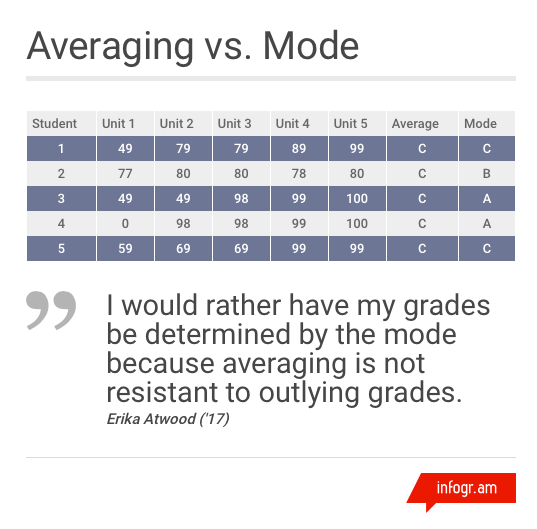Franz framework for grading focuses on performance
Government teacher, Mr. Franz, uses a different approach to evaluating students’ grades.

October 6, 2016
 Brooke Barber
Brooke Barber
With the end of the quarter rapidly approaching, students are beginning to take advantage of the newly introduced StudentVUE, scouring the “Score” column to review their grades. Although Madison students are known for outstanding academic performance, the nature of averaging often allows a single, meager score to drag the overall down. For students of Frank Franz, an AP Government teacher at Madison, however, this is a bygone scenario.
Franz employs an unorthodox grading technique known as the “mode,” where a student’s most frequently earned letter grade becomes the overall grade, brushing aside the more familiar practice of calculating the average.
“A few years ago I moved to use the mode to determine student grades,” Franz said in an introduction video for his Government classes. “I do not average grades during the quarter. What I do is look at [a student’s] most frequent grade earned over all objectives.”
Franz implemented his policy with ease.
“Before I presented the idea to my administrator, I sat down with a year’s worth of grades and changed each number grade to a whole letter grade to see if changing to the mode would benefit or hurt students,” Franz said. “The result was that, for the majority of students, there were no wild swings in grades one way or the other. ‘A’ range students had a mode of As, ‘B’ range students had a mode of B, etc.”
In order to fairly calculate the mode, Franz employs a standards based learning structure. His framework involves dividing units into multiple objectives and considering grades earned on both formative and summative assessments, allowing students to demonstrate their mastery of each topic.
Franz’s students are already expressing approval for his method as it eliminates the unrelenting pressure to achieve lofty letter grades on every assignment, promoting progression of understanding instead.
“I think the mode is better than averaging grades because it showcases how the student actually performs in class over a long period of time rather than an overall grade being affected by one or two bad days,” Abby Gay (‘17) said.
Erika Atwood (‘17) agrees. “I would rather have my grades be determined by the mode because averaging is not resistant to outlying grades,” she said.
However, as with any new implementations, there are minor confusions. A common query concerning the system is determining the grade of a student with a “mode gap” as Franz puts it, or two non-consecutive modes, an equal number of two different letter grades, such as two As and two Cs. In this case, the letter grade between the two determines the student’s grade. Moreover, a student with two consecutive modes – for instance, three As and three Bs – earns the higher of the two letter grades.
Although the policy does present a few challenges, Franz addresses these loopholes in his introduction video and makes it clear he will continue to be a proponent of the mode grading system.
“I flipped my classes [many] years ago and went to a standards-based learning model a few years ago, both of which are spreading at Madison; I’ll keep plugging away and telling anyone who is interested how the mode works,” he said.


